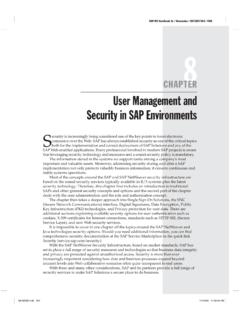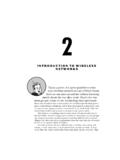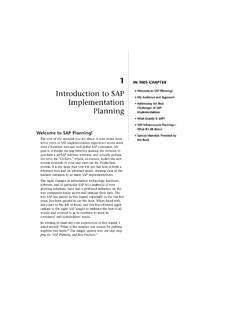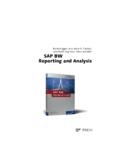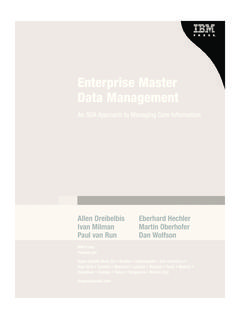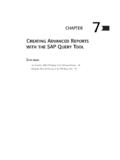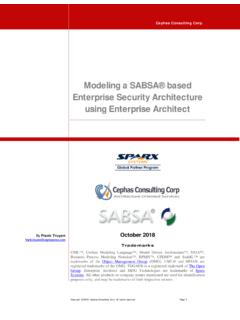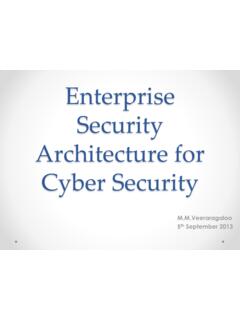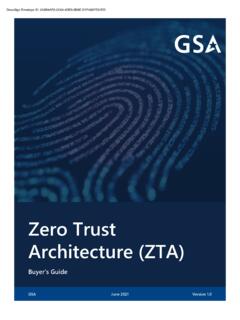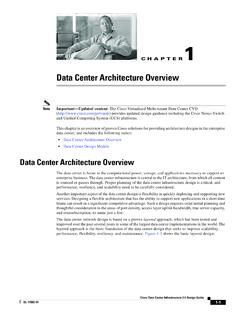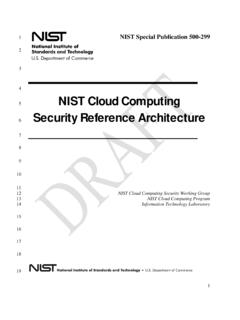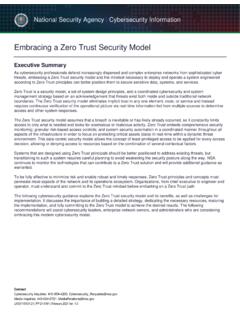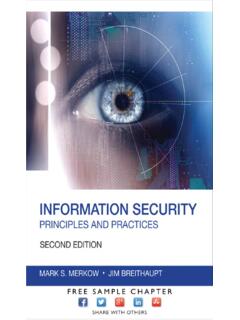Transcription of Chapter 6 - Domain 5: Security architecture and design
1 CHAPTERD omain 5: Securityarchitecture and design6 EXAM OBJECTIVES IN THIS Chapter Secure System design Concepts Secure Hardware architecture Secure Operating System and Software architecture System Vulnerabilities, Threats and Countermeasures Security Models Evaluation Methods, Certification and AccreditationUNIQUE TERMS AND DEFINITIONS RAM Random Access Memory, volatile hardware memory that loses integ-rity after loss of power Reference Monitor Mediates all access between subjects and objects ROM Read Only Memory, nonvolatile memory that maintains integrity afterloss of power TCSEC Trusted Computer System Evaluation Criteria, also known as theOrange Book Trusted Computing Base (TCB) The Security -relevant portions of a computersystem Virtualization An interface between computer hardware and the operatingsystem, allowing multiple guest operating systems to run on one host computerINTRODUCTIONS ecurity architecture and design describes fundamental logical hardware, operatingsystem, and software Security components, and how to use those components todesign, architect, and evaluate secure computer systems.
2 Understanding these funda-mental issues is critical for an information Security architecture and design is a three-part Domain . The first part coversthe hardware and software required to have a secure computer system. The secondpart covers the logical models required to keep the system secure, and the third partcovers evaluation models that quantify how secure the system really Study Guide. DOI: 2010 Elsevier, Inc. All rights SYSTEM design CONCEPTSS ecure system design transcends specific hardware and software implementationsand represents universal best hardware and software functionality into modular tiers. Thecomplexity of an issue such as reading a sector from a disk drive is contained toone layer (the hardware layer in this case). One layer (such as the application layer)is not directly affected by a change to another. Changing from an IDE (IntegratedDrive Electronics) disk drive to a SCSI (Small Computer System Interface) drivehas no effect on an application which saves a file.
3 Those details are containedwithin one layer, and may affect the adjoining layer OSI model (discussed in Chapter 8, Domain 7: Telecommunications andNetwork Security ) is an example of network layering. Unlike the OSI model, thelayers of Security architecture do not have standard names that are universal acrossall architectures. A generic list of Security architecture layers is as device our previous IDE!SCSI drive example, the disk drive in the hardware layerhas changed from IDE to SCSI. The device drivers in the adjacent layer will alsochange. Other layers, such as the applications layer, remain unnecessary details from the user. Complexity is the enemy ofsecurity: the more complex a process is, the less secure it is. That said, computersare tremendously complex machines. Abstraction provides a way to manage user double-clicks on an MP3 file containing music, and the music plays viathe computer speakers. Behind the scenes, tremendously complex actions are tak-ing place: the operating system opens the MP3 file, looks up the application asso-ciated with it, and sends the bits to a media player.
4 The bits are decoded by amedia player, which converts the information into a digital stream, and sendsthe stream to the computer s sound card. The sound card converts the stream intosound, sent to the speaker output device. Finally, the speakers play of calculations are occurring as the sound plays, while low-level devicesare means the user simply presses play and hears Chapter 6 Domain 5: Security architecture and designSecurity DomainsAsecurity domainis the list of objects a subject is allowed to access. More broadlydefined, domains are groups of subjects and objects with similar Security require-ments. Confidential, Secret, and Top Secret are three Security domains used bythe Department of Defense (DoD), for example. With respect to kernels,two domains are user mode and kernel mode (also known as supervisor mode) is where the kernel lives, allow-ing low-level access tomemory,CPU, disk, etc. It is the most trusted and powerfulpart of the system. User mode is where user accounts and their processes live.
5 Thetwo domains are separated: an error or Security lapse in user mode should notaffect the kernel. Most modern operating systems use both modes; some simpler(such as embedded) and older (such as Microsoft DOS) operating systems runentirely in kernel Ring ModelThering modelis a form of CPU hardware layering that separates and protectsdomains (such as kernel mode and user mode) from each other. Many CPUs, suchas the Intel 86 family, have four rings, ranging from ring 0 (kernel) to ring 3(user), shown inFigure The innermost ring is the most trusted, and eachsuccessive outer ring is less rings are (theoretically) used as follows: Ring 0: Kernel Ring 1: Other OS components that do not fit into Ring 0 Ring 2: Device drivers Ring 3: User applicationsRing 0 KernelRing 1 Ring 2 Ring 3 UserFIGURE Ring system design conceptsProcessescommunicate between the rings viasystem calls, which allow processes tocommunicate with the kernel and provide a window between the rings.
6 A user run-ning a word processor in ring 3 presses save : a system call is made into ring 0, ask-ing the kernel to save the file. The kernel does so, and reports the file is calls are slow (compared to performing work within one ring), but providesecurity. The ring model also provides abstraction: the nitty-gritty details of savingthe file are hidden from the user, who simply presses the save file 86 CPUs have four rings and can be used as described above, thisusage is considered theoretical because most 86 operating systems, includingLinux and Windows, use rings 0 and 3 only. Using our save file example withfour rings, a call would be made from ring 3 to ring 2, then from ring 2 to ring1, and finally from ring 1 to ring 0. This is secure, but complex and slow, so mostmodern operating systems opt for simplicity and new mode calledhypervisor mode(and informally called ring 1 ) allowsvirtual guests to operate in ring 0, controlled by the hypervisor one ring below. The Intel VT (Intel Virtualization Technology, aka Vanderpool ) and AMD-V(AMD Virtualization, aka Pacifica ) CPUs support a and Closed SystemsAnopen systemuses open hardware and standards, using standard componentsfrom a variety of vendors.
7 An IBM-compatible PC is an open system, using a stan-dard motherboard, memory, BIOS, CPU, etc. You may build an IBM-compatiblePC by purchasing components from a multitude of vendors. Aclosed systemusesproprietary hardware or Open System is not the same as Open Source. An open system uses standard hardwareand software. Open Source software makes source code publicly HARDWARE ARCHITECTURES ecure Hardware architecture focuses on the physical computer hardware requiredto have a secure system. The hardware must provide confidentiality, integrity, andavailability for processes, data, and System Unit and MotherboardThesystem unitis the computer s case: it contains all of the internal electroniccomputer components, including motherboard, internal disk drives, power supply,etc. Themotherboardcontains hardware including the CPU, memory slots, firm-ware, and peripheral slots such as PCI (Peripheral Component Interconnect) keyboard unit is the external Chapter 6 Domain 5: Security architecture and designThe Computer BusAcomputer bus, shown inFigure , is the primary communication channel ona computer system.
8 Communication between the CPU, memory, and input/outputdevices such as keyboard, mouse, display, etc., occur via the and southbridgeSome computer designs use two buses: anorthbridgeandsouthbridge. The namesderive from the visual design , usually shown with the northbridge on top, and thesouthbridge on the bottom, as shown inFigure The northbridge, also called theMemory Controller Hub (MCH), connects the CPU toRAMand video southbridge, also called the I/O Controller Hub (ICH), connects input/outputCPUALUCUBUSRAMHard DiskDisplayKeyboard/MouseCDFIGURE computer DiskKeyboard/MouseCDNorthbridgeSouthbrid geVideo MemoryUSB PortsFIGURE and southbridge hardware architecture (I/O) devices, such as disk, keyboard, mouse, CD drive, USB ports, etc. The north-bridge is directly connected to the CPU, and is faster than the CPUThe Central Processing Unit (CPU) is the brains of the computer, capable ofcontrolling and performing mathematical calculations. Ultimately, everything acomputer does is mathematical: adding numbers (which can be extended to sub-traction, multiplication, division, etc), performing logical operations, accessingmemory locations by address, etc.
9 CPUs are rated by the number of clock cyclesper second. A GHz Pentium 4 CPU has billion clock cycles per Logic Unit and Control UnitThearithmetic logic unit(ALU) performs mathematical calculations: it com-putes. It is fed instructions by thecontrol unit, which acts as a traffic cop, sendinginstructions to the & executeCPUs fetch machine language instructions (such as add 1 1 ) and execute them(add the numbers, for answer of 2 ). The fetch and execute (also called Fetch,Decode, Execute, or FDX) process actually takes four Instruction Instruction Instruction (save) result 1 These four steps take one clock cycle to multiple steps into one combined process, allowing simulta-neous fetch, decode, execute, and write steps for different instructions. Each partis called a pipeline stage; the pipeline depth is the number of simultaneous stageswhich may be completed at our previous fetch and execute example of adding 1 1, a CPU withoutpipelining would have to wait an entire cycle before performing another computa-tion.
10 A four-stage pipeline can combine the stages of four other Instruction Instruction 2, Decode Instruction Instruction 3, Decode Instruction 2, Execute Instruction Instruction 4, Decode Instruction 3, Execute Instruction 2, Write (save)result Instruction 5, Decode Instruction 4, Execute Instruction 3, Write (save)result 2, is like an automobile assembly line: instead of building one car at atime, from start to finish, lots of cars enter the assembly pipeline, and discrete170 Chapter 6 Domain 5: Security architecture and designphases (like installing the tires) occur on one car after another. This increasesthe that an asynchronous event has occurred. CPU interrupts area form of hardware interrupt that cause the CPU to stop processing its current task,save the state, and begin processing a new request. When the new task is complete,the CPU will complete the prior and threadsAprocessis an executable program and its associated data loaded and running inmemory. A heavy weight process (HWP) is also called a task.
